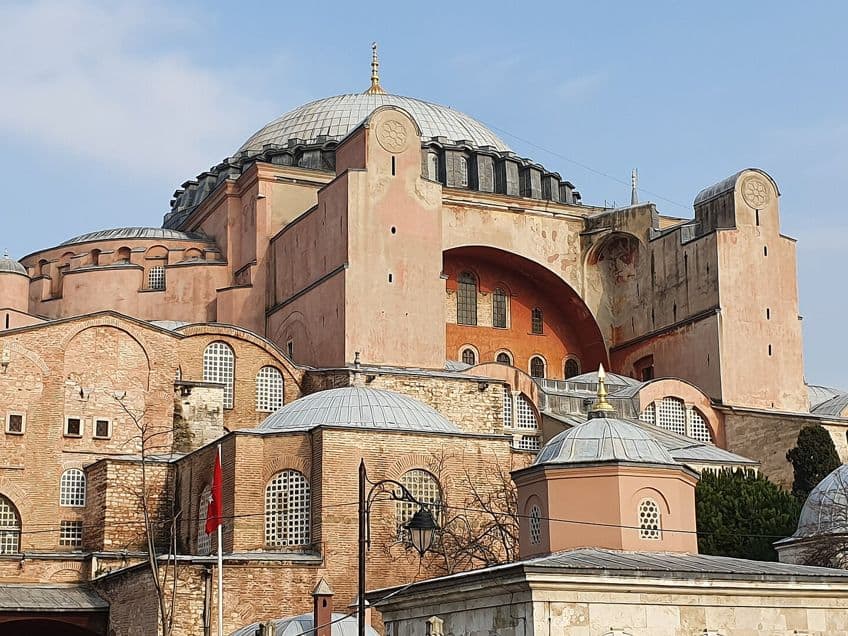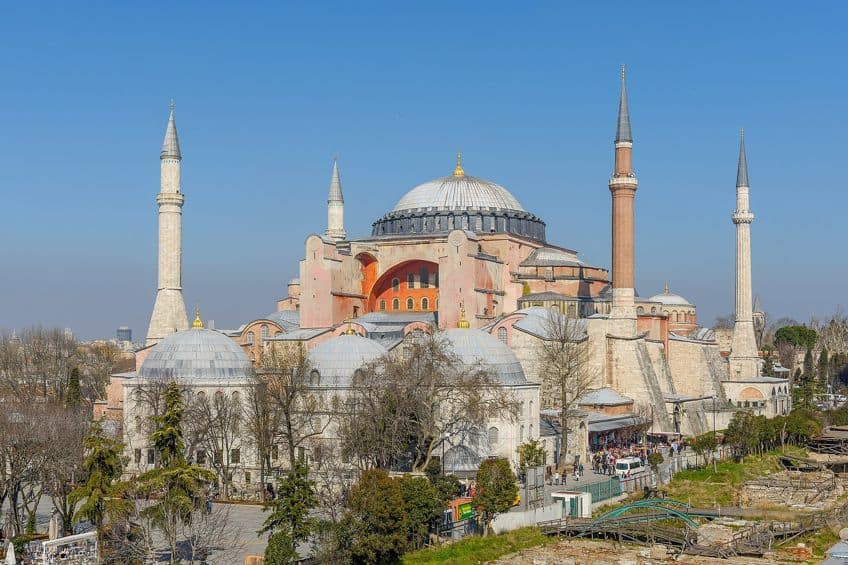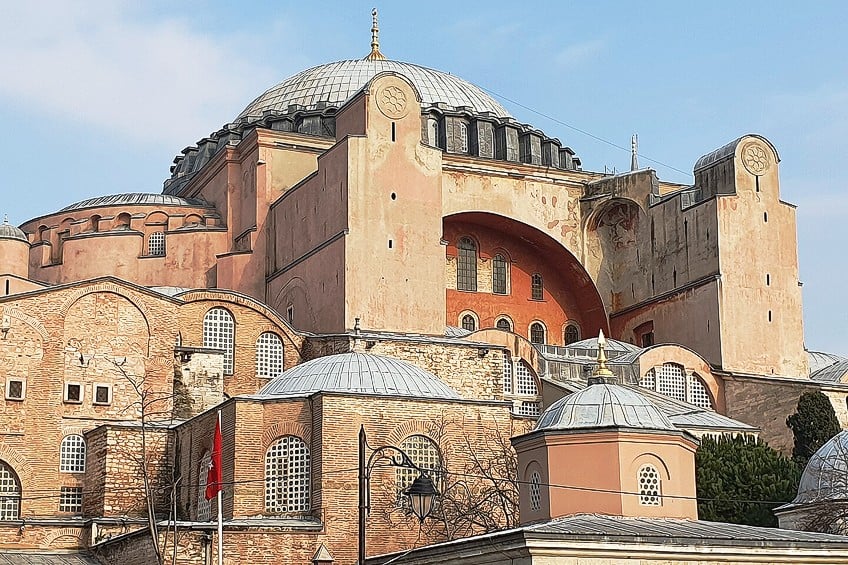Hagia Sophia in Istanbul – A Timeless Beauty in Turkey
The Hagia Sophia is one of the most gorgeous instances of Byzantine architecture to have ever been constructed. However, where was the Hagia Sophia built? Why was the Hagia Sophia built? When was the Hagia Sophia Built? Who built the Hagia Sophia? These questions, and more, will be answered as we examine the history of the Hagia Sophia to understand why it is such an important piece of church and mosque architecture. Keep reading to learn more about the Hagia Sophia!
A Look at the Hagia Sophia in Istanbul
| Architect | Isidore of Miletus (6th century) and Anthemius of Tralles (6th century) |
| Date Constructed | 532 – 537 |
| Function | Mosque |
| Materials Used | Brick, stone, marble, concrete, and gold |
| Height | 55.6 meters (or 182.5 ft) |
| Location | Istanbul, Turkey |
The Hagia Sophia in Istanbul is one of the most important and influential pieces of religious architecture to have ever been designed, and it has held this prime place of importance for many centuries in two major religious traditions: Christianity and Islam. This famous structure has served in both roles at different points in its history.
Let us have a look at this immensely famous church and mosque to see why it has become such an important and influential piece of religious architecture.
The History of Hagia Sophia
The site on which the Hagia Sophia in Istanbul was eventually constructed is an ancient site in the history of Christianity, and as Constantinople (modern-day Istanbul) became a central location in the Eastern Orthodox Church, it makes sense that the city’s main church would be an important site. The first church constructed in that location was very different from what would eventually come, but it was constructed in the 4th century CE.
That first church, which was also known as the Magna Ecclesia, burnt down at the start of the 5th century.
A second church was then constructed on the same spot, but then, that church also caught fire. It is only here where the history of Hagia Sophia in Istanbul truly began. In early 532, the Byzantine emperor, Justinian I, ordered a larger and far more elaborate structure than had ever existed before. The second church had only burnt down a few weeks prior, but it was time to rebuild. This new church would be constructed between 532 and 537. It was specifically designed to be an exemplary iteration of Byzantine architecture and a stunning example of religious architecture too. It is often considered to be the absolute height of Byzantine architecture, but those features will be discussed in more detail below.

Upon its completion, it was heralded as the largest church in the world in terms of interior space, and it was also one of the first to make use of a pendentive dome. That third church is the one that still stands to this day, but the history of Hagia Sophia in Istanbul does not end there. This church was a centerpiece of the architectural work of Justinian I’s reign, and it was part of his many attempts to restore the Byzantine Empire into something great once again. His achievements would be far more than only architectural because he also achieved many victories in cultural and military terms.
The Hagia Sophia church remained one of the most important epicenters of those achievements.
The Hagia Sophia in Istanbul would be the most important location for the Eastern Orthodox Church for nearly a millennium. However, it did, for a few decades, become a Catholic church, but was restored to its original purpose in 1261 when the Byzantine Empire was restored. However, the Fall of Constantinople would come in 1453 when the Ottoman Empire invaded, and the Hagia Sophia church was officially turned into a mosque. The stunning piece of religious architecture would become a major influence on Islamic architecture thereafter, and it would inspire many different mosques around the world. While the Christian aspects of the Hagia Sophia in Istanbul were removed, such as the bells, altar, and many pieces of artwork, it did ultimately remain in its original state. The Hagia Sophia church, now mosque, had become far too important to destroy.

The history of Hagia Sophia was still not over though. When the Ottoman Empire fell at the conclusion of the First World War, there would be seismic changes in the Turkish government, and one of the decisions that was ultimately made was to turn this famed structure into a secular museum instead. Ever since 1935, it had been a museum. It was actually the most popular tourist destination in all of Turkey into the modern-day, but changes have once again occurred.
This will be discussed a little later in this article though.
The Architecture of Hagia Sophia
The Hagia Sophia in Istanbul is considered to be one of the great examples of Byzantine architecture to have ever been created, and it became an incredibly influential piece of religious architecture that inspired countless churches and mosques around the world. When the church was constructed, it was also the largest church in the world and would remain that way for nearly a millennium, but what about the actual architecture of the Hagia Sophia? The Hagia Sophia was constructed using brick, and that brick design was covered in a stunning array of mosaic art pieces. The Hagia Sophia in Istanbul is particularly well-known for its massive dome and arched windows that surround the structure. The dome itself was also one of the tallest ever designed, and it sits at a height of 55.6 m (or 182.5 ft) in height.
The dome has become one of the most important elements of the design as it was the first large-scale use of a pendentive dome.
This means that the dome itself sits atop four triangular segments that curve upwards. The dome itself is placed on top of this structure, and the Hagia Sophia in Istanbul popularized the use of this technique around the world, and it was only surpassed when St Peter’s Basilica was completed centuries later. This brick dome was actually a problem as soon as it was constructed, as it is incredibly heavy. Part of the dome entirely collapsed in the mid-6th century, and when it was reconstructed, it needed the addition of various ribs to hold it up. Sections of this have also collapsed, and restorations have needed to be made.

There were also additions made to the Hagia Sophia in Istanbul after it became a mosque. Mosque architecture necessitates the use of minarets, which are towers used to announce prayers, and there are now four minarets that surround the structure. These later additions are not part of Byzantine architecture at all, and they are technically located outside of the main structure but do form part of the property as a whole. However, while the minarets were added significantly later, some of the mosaics were added shortly after the Hagia Sophia church was constructed in the first place. More mosaics were added in the 10th and 12th centuries, but during the Sack of Constantinople in 1204, many of the mosaics were either torn down or vandalized, and many of the golden mosaics were entirely stolen.
This means that the original structure that once contained a stunning array of artworks is no longer the structure that stands in Istanbul today. The ravages of war have little interest in historical landmarks, after all.
Other than these main aspects of the architecture of the Hagia Sophia in Istanbul, there are also various other features worth a brief mention. There are several ancient doors that have survived through the centuries, a “crying column” that is said to have mystical properties, and even a Viking inscription that simply states: “Halvdan was here”. This last interesting feature was likely carved into the wall by a Viking mercenary who was working in the region.

All in all, the Hagia Sophia in Istanbul has remained one of the most important pieces of religious architecture in the world and a major influence on both Christian and Islamic architectural traditions. The building is also still standing to this day, but its function has somewhat changed over the last few years.
The Present Uses of Hagia Sophia
The Hagia Sophia in Istanbul served as a museum ever since 1935, and that decision was hailed as a welcome move by the various churches that have been inspired by the Hagia Sophia over the centuries. The secular museum allowed those of all faiths to enjoy the stunning architectural achievements of the Byzantine Empire. However, a change was made very recently at the time of writing. In 2020, the Turkish government decided to overturn the 1934 decree that transformed the building into a secular structure. It was claimed that the previous decision had been unlawful, and the Hagia Sophia in Istanbul, which had been a church and a mosque, was transformed back into a mosque.
It was claimed that the sultan had the power to do this as the structure was also, technically, his property.
There were many who decried this decision as the Hagia Sophia in Istanbul had become a location for both Christians and Muslims to congregate and appreciate. The backlash was global, and even UNESCO criticized the decision from a cultural perspective. Furthermore, there were concerns that, as a museum, the old Christian iconography had been preserved, but as a mosque that may have no longer been a priority.

This all means that the Hagia Sophia in Istanbul is, once again, in operation as a religious structure despite significant backlash to that decision from various local and international groups. Regardless of the desires of anyone else, this ancient piece of Byzantine architecture is once again fulfilling a religious function.
With that, we have come to the end of our discussion about the Hagia Sophia in Istanbul. We have examined the history of Hagia Sophia, the stunning Byzantine architecture of the building, and the current uses of the structure. The Hagia Sophia church, mosque, and museum has served as one of the most important and influential pieces of religious architecture ever designed, and is definitely worth a visit!
Frequently Asked Questions
What Is the Hagia Sophia?
The Hagia Sophia in Istanbul was originally constructed as the seat of the Eastern Orthodox Church when Istanbul was still Constantinople. It would become one of the most important pieces of architecture ever designed and an integral part of religious architecture around the world. In 1453, it was converted into a mosque and went on to inspire Islamic as well as Christian architecture around the world. In 1935, it became a secular museum instead but was ultimately turned back into a mosque in 2020. This was a very controversial decision that has not been supported by the various Christian churches that once called the Hagia Sophia in Istanbul their own.
Where Was the Hagia Sophia Built?
The Hagia Sophia church, and later mosque, was built in Constantinople when it was the center of the Byzantine Empire. However, that city is now known as Istanbul and is the capital of Turkey. It is specifically located in the Sultanahmet area of the city, and this has led to it being quite a central location. In addition, because of its present status as one of the most visited tourist destinations in Turkey, it is a location that can be easily reached from various points around this ancient and historic city.
Why Was the Hagia Sophia Built?
The Hagia Sophia in Istanbul was constructed for various reasons. It was, at its most basic, a reconstruction of the second church that had originally been built on that site. It replaced this old, burnt-down church, but when it was constructed, it was designed to be far more intricate than any of the churches that had been built on that site before. The Byzantine Emperor at the time, Justinian I, wanted it to be the home of the Eastern Orthodox Church and a stunning example of Byzantine architecture. This meant that the Hagia Sophia church was constructed to be both a symbol of the Byzantine Empire and as a replacement church.
When Was the Hagia Sophia Built?
The present structure that is the Hagia Sophia in Istanbul was constructed between 532 and 537, but the site has been occupied as a church since 360, and so one could claim that those are its earliest origins. It was constructed at the height of the Byzantine Empire under Justinian the Great. The oldest church on that site was far less illustrious than the Hagia Sophia church, which would eventually rise to architectural fame around the world.
Who Built the Hagia Sophia?
The present Hagia Sophia in Istanbul was built under the orders of Justinian I, the Byzantine Emperor, who is often considered to be one of the greatest Byzantine Emperors of all time. The architects who were placed in charge of the Hagia Sophia church were Anthemius of Tralles and Isidorus of Miletus. They were tasked with designing the most magnificent church in the Byzantine tradition, and they appear to have succeeded. The Hagia Sophia in Istanbul is considered to be the very height of the architectural might of the Byzantine Empire, and so those who designed this structure achieved what they set out to do.
Justin van Huyssteen is a writer, academic, and educator from Cape Town, South Africa. He holds a master’s degree in Theory of Literature. His primary focus in this field is the analysis of artistic objects through a number of theoretical lenses. His predominant theoretical areas of interest include narratology and critical theory in general, with a particular focus on animal studies. Other than academia, he is a novelist, game reviewer, and freelance writer. Justin’s preferred architectural movements include the more modern and postmodern types of architecture, such as Bauhaus, Art Nouveau, Art Deco, Brutalist, and Futurist varieties like sustainable architecture. Justin is working for artfilemagazine as an author and content writer since 2022. He is responsible for all blog posts about architecture.
Learn more about Justin van Huyssteen and about us.
Cite this Article
Justin, van Huyssteen, “Hagia Sophia in Istanbul – A Timeless Beauty in Turkey.” artfilemagazine – Your Online Art Source. October 31, 2023. URL: https://artfilemagazine.com/hagia-sophia-in-istanbul/
van Huyssteen, J. (2023, 31 October). Hagia Sophia in Istanbul – A Timeless Beauty in Turkey. artfilemagazine – Your Online Art Source. https://artfilemagazine.com/hagia-sophia-in-istanbul/
van Huyssteen, Justin. “Hagia Sophia in Istanbul – A Timeless Beauty in Turkey.” artfilemagazine – Your Online Art Source, October 31, 2023. https://artfilemagazine.com/hagia-sophia-in-istanbul/.



